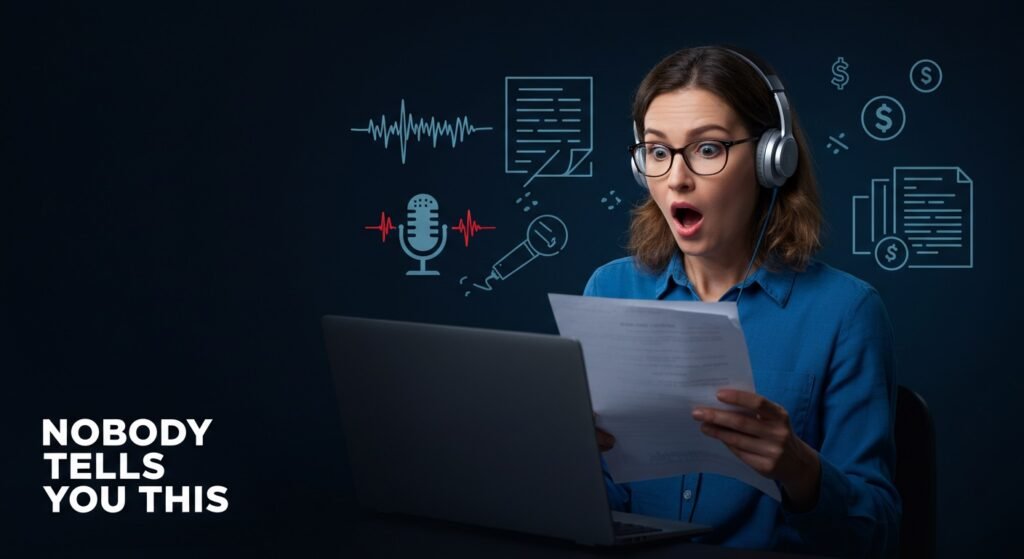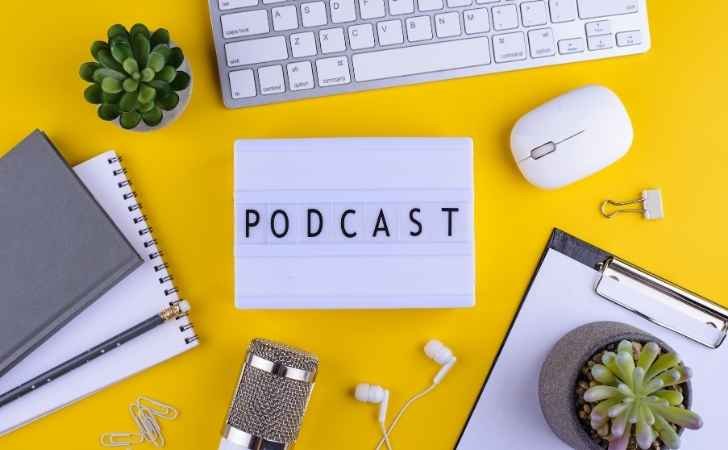AFFILIATE DISCLOSURE
This post may contain affiliate links. An affiliate means Escribr may earn referral fees if you make a purchase through our link without any extra cost to you. It helps to keep this blog afloat. Thanks for your support!
Did you know that by visiting this blog, you are doing good in the world? READ THIS.
The transcription industry is booming. With the explosion of content—podcasts, YouTube videos, webinars, online courses—more and more creators, professionals, and corporations are seeking transcription services.
On the surface, it sounds like a straightforward business: listen, type, deliver. But beneath that simplicity lies a game-changing secret that could separate struggling freelancers from thriving business owners.
If you’re already in the transcription business, or thinking about entering it, you’ve probably heard the usual advice:
- Improve your typing speed
- Learn to use transcription software
- Choose a niche
All of these are important, but none of them are the secret sauce. Today, we’ll uncover the one powerful truth that most successful transcription entrepreneurs quietly leverage—yet rarely talk about.
2. The Rise of the Transcription Industry
Before we get to the hidden secret, let’s understand why transcription is more relevant than ever.
Global Content Explosion
- In 2024 alone, over 464.7 million podcast episodes were released globally.
- YouTube sees over 500 hours of video uploaded every minute.
- Virtual meetings via Zoom, Teams, and Google Meet are now integral to business operations.
All this content needs to be searchable, readable, accessible, and repurposable—making transcription essential.
Demand Across Multiple Sectors
- Legal: Court proceedings, depositions
- Medical: Patient notes, consultations
- Academic: Lectures, research interviews
- Corporate: Meeting minutes, internal training
- Creative: Podcast shows, YouTube content, documentary subtitles
Clearly, the need is everywhere. But so is the competition. That’s why knowing the industry secret can put you far ahead.
3. The Secret Nobody Talks About
Here it is.
Transcription is not a typing business. It’s a data business.
Read that again.
The most successful transcription entrepreneurs know that what they’re really selling is organized, searchable, strategic information—not just “text.”
Most people entering the field focus on typing fast or formatting accurately. Those are baseline skills. The real value lies in understanding and structuring information for downstream use—search engines, analytics, repurposing, accessibility, or compliance.
Let’s break that down.
4. Why This Secret Matters More Than Ever
A. Clients Want Value, Not Just Words
Imagine a client uploads a podcast and wants a transcript. They don’t just want raw text—they want:
- Speaker labels
- Timestamped highlights
- SEO-friendly formatting
- Quotes they can use on social media
- Summaries or show notes
- Keywords to rank for Google
That’s content strategy, not just transcription.
B. Transcripts Feed SEO Machines
Bloggers, YouTubers, and marketers use transcripts to:
- Rank in search engines
- Feed AI tools like ChatGPT with structured input
- Repurpose into articles, tweets, newsletters, etc.
- Improve accessibility (ADA compliance)
By recognizing this, top transcriptionists package their service around results rather than deliverables.
C. The AI Factor
With tools like Otter, Descript, Whisper, and Trint, people think the transcription business is dying.
It’s not.
AI produces raw transcripts. You still need a human brain to make it usable, accurate, and impactful.
If you present yourself as a Content Data Specialist, SEO Transcript Consultant, or Repurposing Partner, you’re not competing with $0.10/minute machines. You’re providing strategic business value.
5. How to Apply the Secret to Grow Your Business
Let’s get tactical.
Step 1: Change Your Mindset
Stop selling “transcription.” Start selling:
- Content extraction and transformation
- SEO-ready transcripts
- Multimedia content repurposing
- Speaker analytics and highlight summaries
Position your service as a solution, not a task.
Step 2: Learn Value-Added Skills
What sets high-income transcriptionists apart? Skills like:
- SEO: Knowing keyword placement in transcripts
- Summarization: Writing show notes or summaries
- Timestamping and metadata tagging
- Content strategy: Identifying reusable moments
Even light training in these areas can help you 5x your rates.
Step 3: Package and Productize
Don’t charge only per audio minute. Offer packages like:
- Podcast Growth Bundle: Transcription + show notes + quotes + timestamps
- SEO Blog Package: Transcription turned into a 1,000-word blog
- Accessibility & Compliance Pack: Transcripts with captions, metadata, and ADA checks
Now you’re not just a transcriptionist—you’re a content partner.
Step 4: Niche Down With Authority
Pick a niche and go deep. Examples:
- Legal transcription with certification
- YouTube channels needing SEO-rich subtitles
- Academic research with qualitative analysis support
- Coaches & online educators needing transcripts turned into courses or ebooks
Niche expertise = higher trust = higher prices.
6. Mistakes to Avoid
❌ Focusing Only on Speed
Typing 120 WPM doesn’t matter if your output isn’t usable.
❌ Competing on Price
Race-to-the-bottom pricing kills your business. Add value instead.
❌ Ignoring Client Goals
Don’t just “complete a task.” Ask, “What will they do with this transcript?”
❌ Relying Solely on AI Tools
AI is a tool—not a service. Human editing, structuring, and context make the transcript useful.
7. Tools and Resources for Modern Transcriptionists
You’ll need a solid tech stack to transform from a typist to a content partner.
Here are some recommended tools that make transcription faster, smarter, and scalable:
AI + Editing
- Descript – Best for editing audio + video + transcripts
- Whisper by OpenAI – Free, highly accurate base transcription
- Otter – Great for meetings and collaborative transcripts
- Trint – Enterprise-level transcription and analytics
Where unlimited transcription Changes the Game
One major limitation many transcription freelancers face is cost scaling—most platforms charge per audio minute or have tight usage caps. If you’re working with multiple clients or creating a volume-based business (e.g. podcast agencies or YouTube support services), those per-minute fees add up fast and eat into your profit margin.
That’s where a platform like AccurateScribe becomes extremely useful.
AccurateScribe offers unlimited transcription at a flat rate, which changes the way you think about volume and pricing. Instead of worrying about how much each audio file costs to process, you can focus on how to add value—like offering more in-depth edits, extra summaries, or full blog conversions—without worrying about overage fees.
It also allows you to:
- Take on more clients confidently
- Bundle services affordably
- Experiment with repurposing workflows without the pressure of cost
For anyone serious about building a scalable, sustainable transcription business, having an unlimited transcription platform like AccurateScribe in your toolkit gives you both flexibility and margin control, which is key when you’re turning transcripts into monetized content assets.
⚡ Pro tip: Tools like AccurateScribe become exponentially more valuable when paired with your own frameworks for content delivery (e.g. show notes, quote cards, summaries). The unlimited model supports creative freedom.
SEO & Content Tools
- Surfer SEO or Frase – For keyword optimization
- ChatGPT / Claude – To turn transcripts into blog posts or summaries
- Canva – Turn quotes into shareable visuals
- Hemingway or Grammarly – Improve readability
Delivery Tools
- Notion or Google Docs – Organize and deliver content neatly
- Loom – Send a quick video to explain how to use the content
- Zapier – Automate delivery, tagging, and file formatting
8. Real-Life Case Studies
A. The YouTube Growth Consultant
Sarah started transcribing for a YouTube creator. She noticed keywords weren’t optimized. She offered SEO-enhanced transcripts and added video descriptions + timestamps.
Within 6 months:
- Channel traffic grew 30%
- Her income tripled
- She now runs a team of 3 transcriptionists
B. The Legal Transcriptionist Who Doubled Rates
Tom specialized in depositions but added AI timestamp syncing and legal formatting. He marketed as a Legal Data Partner, not a typist.
His rates went from $1.20/audio minute → $3.50/audio minute.
C. Podcast Show Notes Pro
Mina offered not just transcripts but LinkedIn quotes, SEO blog posts, and 30-second snippets per episode. Her clients saved 4 hours/week on content creation.
Wrap-Up
The transcription business isn’t dying. It’s evolving.
And the secret nobody tells you is this:
You’re not in the transcription business. You’re in the information business.
When you embrace this mindset, you stop being just another freelancer. You become a content intelligence partner—someone who extracts, organizes, and amplifies knowledge.
This is what clients pay real money for. Not words on a page. But meaning, structure, and growth.
Transcription is the foundation. But strategy is the ceiling.
FAQs
Q: Is it still worth starting a transcription business in 2025?
A: Absolutely—especially if you niche down and offer value-added services beyond basic typing.
Q: Do I need to be a fast typer?
A: It helps, but comprehension, structure, and editing are more important for high-paying work.
Q: Can AI tools replace me?
A: Not if you evolve. Use AI to boost efficiency but add your human intelligence to organize, optimize, and strategize.
Q: How do I find clients for high-value transcription services?
A: Go where content is created: Podcast groups, YouTube creator forums, LinkedIn, and Upwork—but pitch strategic outcomes, not just deliverables.












